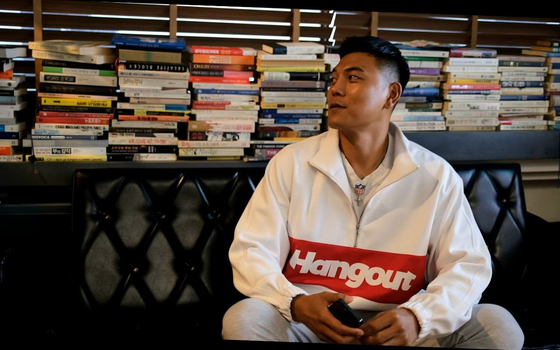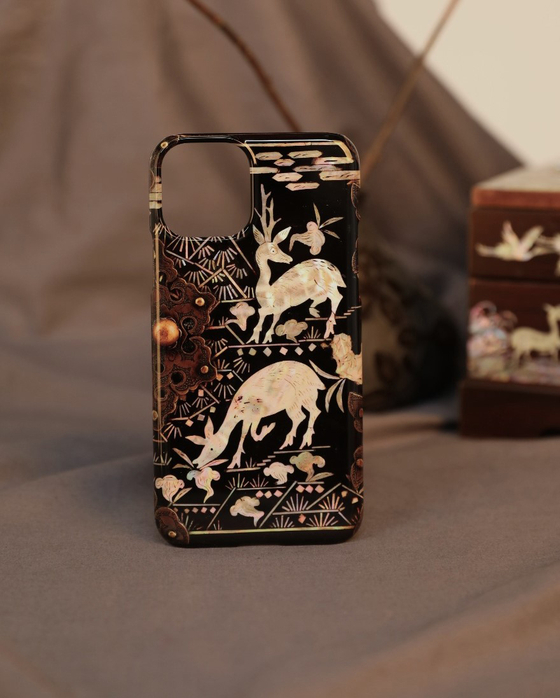Korean design jumps on the K-history bandwagon with traditional motifs
!["Good Luck Fish," lifestyle brand 2nd universe's updated version of the dried pollack tied with silk yarn tradition [2ND UNIVERSE]](https://koreajoongangdaily.joins.com/data/photo/2023/02/05/e3f880eb-5192-43a9-ac1a-f2dc4f3fc180.jpg)
"Good Luck Fish," lifestyle brand 2nd universe's updated version of the dried pollack tied with silk yarn tradition [2ND UNIVERSE]
The city of Seoul has a fantastic collision of old and new. In between its modern buildings, the city boasts beautiful ancient palaces and traditional houses that harmonize with nature.
Trendy buildings these days seem to be bringing that power of Seoul’s contrasting beauty into their designs as many of them have fused the modern with the traditional, like the renovated hanok (traditional Korean building) cafes in Samcheong-dong, or newer buildings that feature traditional Korean designs.
Whatever the method may be, the vibe is still very natural, boosting the understated charm that represents Korea's capital city.
Branching off of these efforts, many brands are taking on the challenge of mixing and matching traditional Korean elements while still staying up-to-date on trends.
The following is a selection by the Korea JoongAng Daily of local fashion or lifestyle brands that have proved popular among the public with their reinterpretations.
![A seonbi, or Joseon era (1392-1910) scholar, T-shirt from Hangout. The logo is made of reflective tape. [HANGOUT]](https://koreajoongangdaily.joins.com/data/photo/2023/02/05/0a78fe9b-add0-4de3-86c3-ee5e5f9a438a.jpg)
A seonbi, or Joseon era (1392-1910) scholar, T-shirt from Hangout. The logo is made of reflective tape. [HANGOUT]
Hangout
Korean history is a common theme in Korean dramas or films, but the same can't easily be said about fashion. This streetwear brand, however, put its own twist on historical elements in a hip way.
Hangout’s designs heavily feature seonbi, scholars from the Joseon Dynasty (1392-1910), and their hats, called gat. While these imageries are usually associated with solemnity and wisdom, in the world of Hangout, they are instead playful and snazzy.
A T-shirt printed with an image of Uhwudong and a bold red Hangout logo across the front is one example of how the brand manifests its traditionally stylish looks.
Uhwudong was a female seonbi who was ultimately executed for committing adultery. Despite her tragic ending, “she’s still part of Korean history, and we thought it would be a great idea to add her to our seonbi outfits,” Seo Mu-bin, co-CEO of Hangout, told the Korea JoongAng Daily.

![Seo Mu-bin, top, and Kang Tae-young, co-CEOs of streetwear brand Hangout [HANGOUT]](https://koreajoongangdaily.joins.com/data/photo/2023/02/05/67cf68dd-3d52-4c99-89e8-865f8e4975f0.jpg)
Seo Mu-bin, top, and Kang Tae-young, co-CEOs of streetwear brand Hangout [HANGOUT]
Hangout was born in 2019 from a crew of friends who would often "hangout" while skateboarding and riding fixed-gear bicycles as college students at the University of the Arts London during the 2000s. The collections are mainly comprised of hoodies, T-shirts and joggers.
But these aren’t your ordinary garments with traditional prints; the brand says its core identity centers on safety. Around 80 percent of its products include reflective tapes, frequently seen in high-visibility clothing worn by construction workers, on its logo, making them flashy and luminescent.
“In London, you’re legally required to wear reflective clothes when you go biking,” Seo said. “But in Korea, there isn’t such a rule, and this inspired us to use the material in our clothes. And since we’re a Korean brand, we also applied elements of seonbi as graphics.”
Seo, along with his friend Kang Tae-young, are co-CEOs of Hangout. The duo’s expertise — Seo’s major in fashion business and Kang’s in graphic and media design — aided in the creation of Hangout’s designs.
“The seonbi was from our Spring/Summer 2022 collection, and it’s still available to purchase because it’s the most popular,” Seo said.
The pieces feature stenciled silhouette prints of seonbi, gat and maehwajeom (traditional prints in the shape of maehwa, or plum flowers).
Maehwa is a symbolic image from Joseon that represented seonbi’s integrity and elegance.
![A maehwajeom (traditional prints in the shape of plum flowers) hoodie by Hangout [HANGOUT]](https://koreajoongangdaily.joins.com/data/photo/2023/02/05/58a7384d-9186-4c99-8583-38b42dc4de9b.jpg)
A maehwajeom (traditional prints in the shape of plum flowers) hoodie by Hangout [HANGOUT]
![The lookbook for Hangout's Spring/Summer 2022 collection, which was centered on images associated with seonbi, or scholars from the Joseon Dynasty [HANGOUT]](https://koreajoongangdaily.joins.com/data/photo/2023/02/05/d02448d8-ca0e-470f-87c8-e1c45cc4a3b1.jpg)
The lookbook for Hangout's Spring/Summer 2022 collection, which was centered on images associated with seonbi, or scholars from the Joseon Dynasty [HANGOUT]
The gat has been used in the context “fear of gat,” which is a witty parody of the American streetwear label Fear of God, and while the traditional gat was usually black, Hangout reversed it to white.
The brand also collaborates with other Korean artists and brands, like with a famous barbershop in Gangnam District, southern Seoul. Seo says that Hangout has plans to further extend its collaborations this year, hinting that one with a famous tattoo shop will be in stores soon.
To hang out with the brand, visit its Instagram @hangout_seoul
![One example of how to use 2nd universe's ″Good Luck Fish″ is to stick it to the front door. [2ND UNIVERSE]](https://koreajoongangdaily.joins.com/data/photo/2023/02/05/b5c3a70f-58a1-4dec-aa6e-cf281df8cbc4.jpg)
One example of how to use 2nd universe's ″Good Luck Fish″ is to stick it to the front door. [2ND UNIVERSE]
2nd universe
Myungtae, or dried pollack, tied with silk yarn and hung on the walls inside one’s home was traditionally considered a token of good fortune. Korean ancestors believed that myungtae were able to monitor any incoming misfortune with their never-closed eyes and eat away at any unclean energy that entered the house with its large mouth.
While the tradition has gone practically extinct in modern society, lifestyle brand 2nd universe attempted to bring the tradition back with an upgrade, using the latest technology: the 3-D printer.
Its digital craft version of the tied myungtae is called “Good Luck Fish” and was designed by CEO Chung Yeon-jung. He learned how to use ZBrush, a digital sculpting program, to finalize the drawing’s 3-D version himself. It took him a total of five years to get to the final result, he said, and he made sure to take part in every step of the process because he wanted to create something that he could “truly call [his] own.”
![Chung Yeon-jung, CEO of Vergum and 2nd universe [2ND UNIVERSE]](https://koreajoongangdaily.joins.com/data/photo/2023/02/05/56b3e9a1-c04e-47ce-9b94-ed147a73cc7d.jpg)
Chung Yeon-jung, CEO of Vergum and 2nd universe [2ND UNIVERSE]
“I remember as a child, I wanted to buy a souvenir after visiting the Bulguksa Temple [in Gyeongju, North Gyeongsang], but I was disappointed in all their designs and quality,” Chung told the Korea JoongAng Daily.
“That experience eventually inspired me to make beautiful products about our culture that we could even introduce overseas. But the thing with artifacts is that we can’t entirely claim them as ours, since our ancestors are the ones who made them. I wanted to go the extra mile aside from just simply modifying their designs.”
“Good Luck Fish,” made from polyvinyl chloride, a type of plastic, sticks to any magnetic surface, including a refrigerator, Chung explained. It comes in multiple unique colors like matte black, fluorescent red and metallic green.
2nd universe is a subsidiary of Vergum, Chung’s design studio in Mapo District, western Seoul. Vergum is an alternative spelling of beogeum, which means “second-best.” It drew inspiration from an expression from “Samguksagi,” the 12th-century historical records of Korea’s Three Kingdoms: “to be frugal but not humble; to be gorgeous but not extravagant.”
“It’s all about moderation,” Chung said. “Beogeum has potential of becoming the best, but it’s about staying modest and refraining from being biased. The last syllable in my name ['jung'] also means beogeum in hanja [the Korean name for Chinese characters].”
![2nd universe's ″Good Luck Fish″ is offered in many different colors, shown here. [2ND UNIVERSE]](https://koreajoongangdaily.joins.com/data/photo/2023/02/05/98c8c488-e4e4-48ae-a82d-06252e0b7a51.jpg)
2nd universe's ″Good Luck Fish″ is offered in many different colors, shown here. [2ND UNIVERSE]
The fish were such a hit that 2nd universe sold 4,000 in just a week through the crowdfunding shopping platform Kakao Makers, and during the Craft Trend Fair 2022 last December, the brand sold 1,000 of them in just four days.
“We saw a lot of customers in their 20s asking what they are, and they really enjoyed learning about myungtae’s history,” Chung said. “People in their 40s, 50s and even 70s, of course, recognized them immediately. I think it’s important that we see more younger people and foreigners become more interested in our roots — and besides, who wouldn’t like some good luck?”
“Good Luck Fish,” 32,000 won ($26) each, is sold through the official website and also at the Leeum Museum of Art’s gift shop in central Seoul. Visit its Instagram (@store.2nduniverse) for updates.
![A passport case with najeon chilgi (lacquerware inlaid with mother-of-pearl) prints, by lifestyle brand Shelly [SHELLY]](https://koreajoongangdaily.joins.com/data/photo/2023/02/05/05622391-f4ea-408a-8ab1-f98377cefe73.jpg)
A passport case with najeon chilgi (lacquerware inlaid with mother-of-pearl) prints, by lifestyle brand Shelly [SHELLY]
Shelly
Najeon chilgi, or lacquerware inlaid with mother-of-pearl, is shiny, smooth and boasts a rainbow of colors. It’s arguably one of Korea’s most beautiful traditional craft techniques. It was often seen in closets or jewelry boxes that date back to the Goryeo Dynasty (918-1392) or Joseon Dynasty.
Nowadays they're much more likely to be found in museums or at a grandparent’s house, but Park So-yeon, CEO of lifestyle brand Shelly, has made the technique more accessible with cases for smartphones, wireless earbuds and passports.
![Park So-yeon, CEO of lifestyle brand Shelly [SHELLY]](https://koreajoongangdaily.joins.com/data/photo/2023/02/05/2a0bff67-c3ee-4ac8-8cd6-5c97fc3ccd39.jpg)
Park So-yeon, CEO of lifestyle brand Shelly [SHELLY]
Shelly is Park’s English name, which aptly represents how her work centers on crafting seashells, or nacre, she told the Korea JoongAng Daily. Park spent almost her entire life learning the craft, especially from her uncle, Park Jae-sung, who is a renowned najeon chilgi craftsperson based in Tongyeong — nicknamed the hometown of najeon chilgi — in South Gyeongsang.
Like his niece, Park Jae-sung is no stranger to trends — in 2011, he collaborated with local tobacco brand ESSE and designed its “Golden Leaf” cigarette pack with printed najeon chilgi.
“Tongyeong has always been famous for najeon chilgi, and I’ve been immersed in it ever since I was little. So over time, I wanted to expand its use in Korea as well as overseas,” CEO Park explained, when asked how she came to start her own brand in July 2021.
The charm of najeon chilgi lies in its smoothness and shininess that shows a prism of colors. The texture is typically illustrated through intricate patterns or drawings, and, in the case of Park’s products: deer, flowers and tigers.
Until now, Shelly’s items were only printed versions, “to manufacture quickly in bulk and because they are more affordable,” Park said, but starting this year she plans to additionally sell ones that are specially handcrafted in small quantities, for a bigger fee.

![From top: Phone case and wireless earbuds cases made with najeon chilgi (lacquerware inlaid with mother-of-pearl) prints, by lifestyle brand Shelly [SHELLY]](https://koreajoongangdaily.joins.com/data/photo/2023/02/05/69c4e852-b0f4-4bcb-b03d-9ba904d31ca7.jpg)
From top: Phone case and wireless earbuds cases made with najeon chilgi (lacquerware inlaid with mother-of-pearl) prints, by lifestyle brand Shelly [SHELLY]
The items are sold through Shelly’s website, the National Museum of Korea’s online and offline gift shops and in crowdfunding sites, which she said has helped foreigners get in contact with her as well.
What could have ended as a simple hobby turned out to be a lifelong task for Park.
Park explained that it has always been her dream to introduce her brand and najeon chilgi to the international audience — “I was so excited to hear from the Korea JoongAng Daily,” she said with a laugh. She was previously invited to do a workshop at Riyadh to teach najeon chilgi techniques.
“It’s exquisite and stunning enough as our tradition,” Park said. “I’ve always wondered how I could revive its beauty, but I always had faith that it was possible; that’s how I’ve been continuing this craft.”
Shelly’s Instagram is @shelly_najeon
BY SHIN MIN-HEE [shin.minhee@joongang.co.kr]










with the Korea JoongAng Daily
To write comments, please log in to one of the accounts.
Standards Board Policy (0/250자)